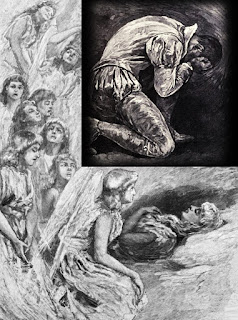The “Lenore” Cycle
 |
| Illustrations for “Lenore” by Henry Sandham, 1886. Harvard University. |
Edgar Allan Poe declared that “The death of a beautiful woman is, unquestionably, the most poetical topic in the world.”[i] It is also, without question, the one which, in his poems, he spent the most time on. In poems such as “The Raven,” “Annabel Lee,” “Lenore,” and “Ulalume,” Poe repeatedly revisits the theme of bereavement over a dead lover.
Although Poe wrote poems with this theme even before his wife Virginia passed away in 1847, it is clear that she is the protagonist in these poems—sometimes, in an anticipatory way, as his mourning her began even before her passing. He famously described the ordeal in a letter, writing that, during her long illness, “I became insane, with long intervals of horrible sanity.” When Virginia finally succumbed, the subject was so painful that Poe’s, perhaps, earliest attempt to write a poem about his grief over her death resulted only in an abortive, but heart-wrenching couplet:
Deep in earth my
love is lying
And I must weep
alone
The remainder of Poe’s dead lover cycle is equally powerful, reflecting a startlingly accurate gamut of the human emotions associated with grief. In fact, if we were to apply the classic Kübler-Ross model of depression—known popularly as “the five stages of grief”—we would find a complete set of the bereavement progression:
1. Denial:
My love, she sleeps!
“The Sleeper” (1831)
2. Anger:
Wretches! ye loved
her for her wealth and hated her for her pride,
And when she fell in
feeble health, ye blessed her—that she died!
How shall the ritual, then, be read?—the
requiem how be sung
By you—by yours,
the evil eye,—by yours, the slanderous tongue
“Lenore” (1843)
3. Bargaining:
“Prophet!” said I,
“thing of evil!—prophet still, if bird or devil!
By that Heaven that
bends above us—by that God we both adore—
Tell this soul with
sorrow laden if, within the distant Aidenn,
It shall clasp a
sainted maiden whom the angels name Lenore”
“The Raven” (1845)
4. Depression:
The skies they were
ashen and sober;
The leaves they were
crispéd and sere—
The leaves they were
withering and sere;
It was night in the
lonesome October
Of my most
immemorial year
“To — ——. Ulalume: A Ballad” (1847)
5. Acceptance:
And so, all the
night-tide, I lie down by the side
Of my darling—my
darling—my life and my bride,
In her sepulchre
there by the sea—
In her tomb by
the sounding sea.
“Annabel Lee” (1849)
In the foregoing presentation, the snippets even ring true to the chronological sequence of the emotions that are represented (the emotions progress in order as time passes). And there are other ‘cycles within the cycle,’ which further vouch for the completeness and richness of the coverage given to the subject. For example, Poe’s offerings cover the different stages of a death narrative: the just died (“Deep In Earth,” “Lenore”); died in the recent past (“Ulalume,” “The Sleeper”); to died in the distant past (“The Raven,” “Annabel Lee”). There is also a variety of genres presented: from tragedy (“To One In Paradise,” “Annabel Lee”); to dark-comedy (“The Sleeper”); to horror (“The Raven,” “Ulalume”).
Because it’s genuine—based on lived experiences and reflections thereon—Poe’s treatment of the dead lover subject is deep, rich, and profound.




Comments
Post a Comment